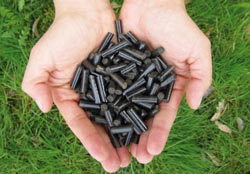Agricultural phosphorus recovery

In the PhosFarm project valuable soil improver and mineral fertiliser salt products are recovered from agricultural residues.<br><br>© Fraunhofer IGB<br>
In the EU-funded PhosFarm project, research and SME partners aim to make organic phosphorus from agricultural residues accessible as a resource for phosphate fertiliser salts. Using immobilised enzymes, organic phosphorus compounds are released from the organic matter and recovered as phosphate.
Phosphorus is an elemental nutrient in agriculture. In response to the increasing demand for phosphorus in the food, biofuels and biobased materials industries, global consumption of phosphate has risen significantly and will continue to increase.
In 2008, approximately 1.4 million tonnes of phosphorus were consumed for the production of synthetic phosphate fertilizer. Moreover, phosphate rock reserves are non-renewable and controlled by only a few countries such as China, Morocco, Tunisia and the U.S.A. As a result, Europe is completely dependent on imports from these countries to cover phosphorus demand.
Besides non-renewable reserves, alternative phosphate resources include municipal wastewater and agricultural organic residues such as livestock manure or digestate from biogas plants. Although new technologies have already been developed for the recovery of dissolved inorganic phosphates in the liquid fractions of municipal and agricultural wastes, solid residues remain a largely untapped source for phosphorus in its organic form. In solid fractions, organic phosphorus bound in biochemical molecules such as phospholipids, nucleotides and nucleic acids offer a bountiful source of phosphorus.
These agricultural residues represent a huge additional reservoir for phosphate recovery: Annually, more than 1,800 million tonnes of manure are generated in the EU and the amount of digestion residues is still increasing. Especially in swine and poultry manure, up to 50 per cent of the overall phosphorus is present in the organic form. In the PhosFarm project, this organic residual matter is to be made accessible as a valuable phosphate resource. The project consortium coordinated by the Fraunhofer Institute for Interfacial Engineering and Biotechnology IGB wants to develop a process and realise a pilot plant that features a controlled enzymatic release of organically bound phosphate, enabling up to 90 per cent recovery of total phosphorus.
This novel strategy is to be carried out using phosphate hydrolysing enzymes immobilised onto suited carriers. “In preliminary experiments, we could show that these enzymes can release inorganic phosphate from model compounds,” explains Jennifer Bilbao, who manages the project at the Fraunhofer IGB. After separation of the solid fraction, the released phosphate dissolved in the liquid fraction can be precipitated as magnesium ammonium phosphate and calcium phosphate, which in turn are directly usable as high value fertilising salts.
The remaining dewatered solid phase is dried with an energy efficient drying process operating with superheated steam instead of hot air. The generated organic soil amendment substrate helps to improve soil fertility. Moreover, according to the requirements of crop species and depending on the soil conditions, the organic soil improvers can be mixed with the recovered mineral fertiliser salts to a suited nutrient composition with a defined N/P ratio.
Bilbao describes the advantages of the envisioned concept: “With our mineral fertiliser salt and organic soil improver products, synthetic phosphate fertilisers are saved and overfertilisation from the application of livestock manure on the agricultural fields is prevented. This realisation of efficient phosphorus recovery not only generates valuable products from an otherwise wasted residue, but at the same time achieves environmentally friendly closed loop recycling.
Since September 2013, “PhosFarm – Process for sustainable phosphorus recovery from agricultural residues by enzymatic process to enable a service business for the benefit of European farm community” – has been funded within the scope of the 7th Framework Research Programme of the EU (Grant Agreement No. 605771). The project partners, besides the Fraunhofer IGB, are research partners VITO (Belgium) and the Swedish University of Agricultural Sciences (SLU, Sweden), as well as the SMEs Chiral Vision (Netherlands), Geltz Umwelttechnologie GmbH (Germany), Heckmann Maschinenbau und Verfahrenstechnik GmbH (Germany), Purines Almazan, S.L. (Spain), Agroenergie Hohenlohe GmbH (Germany), ASB Grünland Helmut Aurenz GmbH (Germany) and Servimed Almazan, S.L. (Spain).
Media Contact
All latest news from the category: Ecology, The Environment and Conservation
This complex theme deals primarily with interactions between organisms and the environmental factors that impact them, but to a greater extent between individual inanimate environmental factors.
innovations-report offers informative reports and articles on topics such as climate protection, landscape conservation, ecological systems, wildlife and nature parks and ecosystem efficiency and balance.
Newest articles

Innovative 3D printed scaffolds offer new hope for bone healing
Researchers at the Institute for Bioengineering of Catalonia have developed novel 3D printed PLA-CaP scaffolds that promote blood vessel formation, ensuring better healing and regeneration of bone tissue. Bone is…

The surprising role of gut infection in Alzheimer’s disease
ASU- and Banner Alzheimer’s Institute-led study implicates link between a common virus and the disease, which travels from the gut to the brain and may be a target for antiviral…

Molecular gardening: New enzymes discovered for protein modification pruning
How deubiquitinases USP53 and USP54 cleave long polyubiquitin chains and how the former is linked to liver disease in children. Deubiquitinases (DUBs) are enzymes used by cells to trim protein…



